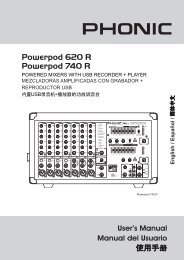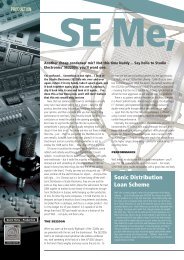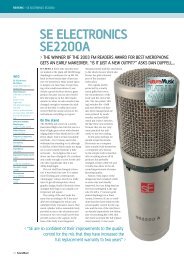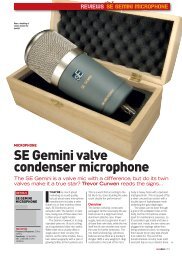Hartke AC150 Acoustic Ribbon Amp - Total Sonic
Hartke AC150 Acoustic Ribbon Amp - Total Sonic
Hartke AC150 Acoustic Ribbon Amp - Total Sonic
Create successful ePaper yourself
Turn your PDF publications into a flip-book with our unique Google optimized e-Paper software.
new gear<br />
<strong>Hartke</strong> <strong>AC150</strong> <strong>Acoustic</strong> <strong>Ribbon</strong> <strong>Amp</strong><br />
A handsome two-channel acoustic amplifier with 150 watts<br />
of tri-amped power and remarkable transparency.<br />
<br />
<br />
At a Glance<br />
<strong>Hartke</strong> Systems was<br />
founded in New York<br />
HIGHLIGHTS<br />
by Larry <strong>Hartke</strong> and<br />
THE SPECS<br />
Ron Lorman in 1984 and<br />
quickly became known for its<br />
line of bass amps and cabinets<br />
that introduced the innovative<br />
aluminum-cone speaker to the<br />
world. As a bass-amp<br />
manufacturer, <strong>Hartke</strong> has years<br />
of experience building cleantoned<br />
amplifiers with a full<br />
frequency range. Now, it has<br />
applied that experience to the<br />
world of acoustic-guitar amps<br />
to create the <strong>AC150</strong> <strong>Acoustic</strong><br />
<strong>Ribbon</strong> amplifier. The midprice,<br />
two-channel <strong>AC150</strong><br />
offers plenty of power, clear<br />
acoustic sound, and an<br />
WATCH FOR<br />
THIS IS COOL<br />
BEST FOR<br />
PRICE<br />
MAKER<br />
in China.<br />
This is not a lightweight amp.<br />
$779 list/$599 street.<br />
extensive list of features sure to be useful to performing guitarists.<br />
Great trebles and a transparent, well-balanced overall sound.<br />
IMPRESSIVE FEATURES FOR TONE TWEAKERS<br />
At first glance, the <strong>AC150</strong> looks rather curious—somewhat reminiscent of an<br />
early-’80s boom box—but with a little investigation it becomes clear that this amp<br />
is a storehouse of useful functions. Channel one includes ¼-inch inputs for both<br />
active and passive pickups, a Phase button, and individual Bass and Treble<br />
controls; channel two has an<br />
XLR input for a microphone<br />
and RCA jacks to plug in a CD<br />
player, iPod, or other linelevel<br />
device. The 24-bit<br />
digital effects processor<br />
has 100 presets that can<br />
be accessed from both<br />
channels with the push<br />
of a button. The<br />
<strong>AC150</strong> houses a<br />
unique speaker<br />
configuration—<br />
four five-inch<br />
drivers, arranged<br />
in stereo, with a<br />
two-by-four-inch<br />
ribbon tweeter. A<br />
tri-amped design splits<br />
150 watts of power, with 50<br />
150 watts. Two channels. Four five-inch, full-range drivers and one 2 x 4 inch<br />
ribbon tweeter. One XLR and two 1 /4-inch inputs. RCA jacks for line in. Bass, Treble,<br />
and Phase controls for channel one. Five-band graphic EQ. Variable notch filter.<br />
24-bit digital effects with 100 presets. Two XLR direct outputs (mono or stereo)<br />
with Pre/Post switch to run signal with or without preamp, equalizer, and effects.<br />
Mono-in, stereo-out effects loop. 48 pounds. 18.85 x 19.75 x 15.25 inches. Made<br />
Kickback cabinet allows you to angle the speakers upward.<br />
Singer-songwriters and gigging guitarists.<br />
<strong>Hartke</strong> Systems: (800) 372-6766; www.hartke.com.<br />
<strong>Hartke</strong> <strong>AC150</strong> <strong>Acoustic</strong> <strong>Ribbon</strong> <strong>Amp</strong><br />
watts going to the drivers on the right<br />
side, 50 to those on the left, and 50 to<br />
the tweeter—effectively giving all<br />
frequencies enough juice to be heard<br />
loud and clear. Add a five-band graphic<br />
EQ and a notch filter—then dress it all<br />
up in a sturdy kickback enclosure, which<br />
allows you to tilt the amp back at an<br />
angle for easy readability and<br />
operation—and you have an amp with<br />
serious performance potential.<br />
CRYSTAL-CLEAR TONAL<br />
REPRODUCTION<br />
Eager to get acquainted with the<br />
<strong>AC150</strong>’s sound, I plugged in my Martin<br />
OM-21 with Fishman Ellipse Blend<br />
electronics as soon as I had the amp out<br />
of the box. Strumming open chords at<br />
low volume with EQ levels flat, the amp’s<br />
sound was so similar to that of my<br />
unamplified guitar that at times it was<br />
hard to tell if the power was really on.<br />
Turning the amp up, I was pleased to<br />
find a louder but still very accurate<br />
reproduction of my acoustic sound.<br />
Following a tip from the instruction<br />
RAY LARSEN<br />
September 2007
manual on how best to set up the amp, I<br />
slightly increased the levels of the Treble<br />
and Bass controls on channel one, then<br />
further sculpted the sound with the fiveband<br />
EQ. I found the level controls to be<br />
quite sensitive, and with modest<br />
adjustments I was able to shape the<br />
sound significantly. The onboard reverbs,<br />
choruses, and echoes were similarly<br />
sensitive—a dash of digital spring reverb<br />
sounded great, but it was easy to turn<br />
the knob too far and end up with a<br />
saturated sound.<br />
Putting the <strong>Hartke</strong> through its paces,<br />
I was consistently impressed by its<br />
transparent, well-balanced sound and<br />
ultraclear trebles. I noticed that the<br />
<strong>Hartke</strong> lacked some of the compression<br />
that I occasionally use on other amplifiers<br />
to add a little punch to individual notes.<br />
When I added a vocal mic to the<br />
second channel, the vocals sounded rich<br />
and clear, and the signals for guitar and<br />
voice were both distinct and easy to<br />
balance. Strumming and singing at the<br />
same time was one of my favorite<br />
applications for the <strong>AC150</strong>, so much so<br />
that I was drawn back to it many times<br />
just to practice my songs. While this is an<br />
excellent amp for singer-songwriters, it’s<br />
important to note that at 48 pounds, it<br />
does take some effort to haul.<br />
I was curious to see how the 150<br />
would cut through the mix with drums<br />
and electric bass added to the equation,<br />
so I brought it to band practice. When I<br />
cranked the Master Volume I got a little<br />
feedback yelp, so I reached for the notch<br />
filter. The first knob allowed me to<br />
isolate the offending frequency, and the<br />
second let me roll back just enough to<br />
lose the feedback, but not the entire<br />
frequency range. With the feedback<br />
effectively clipped, I was able to turn up<br />
to full volume, and as we played through<br />
our set, the <strong>AC150</strong> came through the<br />
mix loud and clear.<br />
THE WRAP<br />
The <strong>Hartke</strong> <strong>AC150</strong> <strong>Acoustic</strong> <strong>Ribbon</strong><br />
amplifier was a pleasure to play through<br />
and is well suited for a variety of<br />
applications—whether you want to<br />
practice at home, play a coffeehouse as a<br />
singer-songwriter, or take the stage with<br />
a band. And with ample wattage, an<br />
excellent speaker complement, and<br />
plentiful features, it offers honest tonal<br />
reproduction at a moderate price—<br />
making it an acoustic amplifier option<br />
worth considering, no matter what your<br />
style.<br />
<br />
From <strong>Acoustic</strong> Guitar, September 2007, issue 177, © 2007 String Letter<br />
Publishing, David A. Lusterman, Publisher. All rights reserved. For more<br />
information on <strong>Acoustic</strong> Guitar, contact String Letter Publishing, Inc.,<br />
255 West End Ave., San Rafael, CA 94901; telephone (415) 485-6946;<br />
fax (415) 485-0831; www.acousticguitar.com.<br />
GOT A QUESTION or comment for <strong>Acoustic</strong> Guitar’s editors? Please send us an e-mail at<br />
editors.ag@stringletter.com or snail-mail <strong>Acoustic</strong> Guitar Editorial, PO Box 767, San<br />
Anselmo, CA 94979. We regularly print reader letters in our Mailbag column and reader<br />
questions and tips in Q&A.<br />
TO SUBSCRIBE to <strong>Acoustic</strong> Guitar magazine, call (800) 827-6837 or visit us online at<br />
www.acousticguitar.com. As a subscriber, you enjoy the convenience of home delivery<br />
and you never miss an issue. Sign up or renew your own subscription now and you can also<br />
purchase a gift subscription for a friend. All subscribers are eligible to receive our free<br />
monthly online newsletter, <strong>Acoustic</strong> Guitar Notes.<br />
TO ADVERTISE in <strong>Acoustic</strong> Guitar, the only publication of its kind read by 150,000 guitar<br />
players and makers every month, call Brannan Willson at (415) 485-6946, ext. 616, or e-mail<br />
him at brannan@stringletter.com.<br />
AG SUBSCRIBERS Take care of all your subscription needs at our online Subscriber<br />
Services page (www.acousticguitar.com): pay your bill, renew, give a gift, change your<br />
address, and get answers to any questions you may have about your subscription.<br />
RETAILERS To find out how you can carry <strong>Acoustic</strong> Guitar magazine in your store,<br />
contact Retail Vision at (800) 381-1288.<br />
ACOUSTIC GUITAR (ISSN 1049-9261) is published monthly by String Letter Publishing,<br />
Inc., 255 West End Ave., San Rafael, CA 94901. Periodicals postage paid at San Anselmo<br />
and additional mailing offices. Printed in USA.<br />
September 2007







